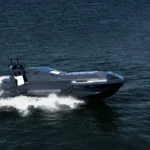At the Association of the United States Army (AUSA) Annual Meeting 2025, the U.S. Army announced the selection of Kymeta’s Osprey™ u8 hybrid SATCOM terminal as a core component of its next-generation tactical network pilot program. The decision underscores a growing shift toward low-profile, resilient communications-on-the-move (COTM) capabilities that can operate in contested environments with reduced electromagnetic signatures.
Kymeta’s Osprey u8: A Tactical SATCOM Game-Changer
The Osprey u8 is a ruggedized version of Kymeta’s electronically steered flat-panel antenna system designed specifically for military and government applications. It supports both geostationary (GEO) and low Earth orbit (LEO) satellite constellations and integrates multi-WAN functionality to provide hybrid connectivity via SATCOM and LTE/5G terrestrial networks.
Key features include:
- Electronically steered Ku-band antenna with no moving parts
- Support for LEO/GEO constellations including OneWeb and Intelsat
- Integrated iDirect modem and Wi-Fi router
- Low-profile form factor optimized for vehicle or command post mounting
- IP66 rating for all-weather operation
The system is designed to deliver high-throughput data links while minimizing detectability—critical for operations in environments where electronic warfare (EW) threats are prevalent.
Selected for Next-Gen Tactical Network Pilot Program
The U.S. Army’s selection of the Osprey u8 comes as part of its Capability Set (CS) modernization roadmap under Project Convergence and Integrated Tactical Network (ITN) initiatives. Specifically, it will be evaluated within Capability Set 25 (CS25), which focuses on scalable command post mobility, resilient transport layers, and contested environment survivability.
The pilot program aims to validate how low-profile SATCOM terminals like the Osprey u8 can enhance:
- Command Post Survivability through reduced RF signature
- Rapid setup/teardown times in dynamic operational environments
- COTM capabilities for mobile headquarters elements
- Interoperability across Joint All-Domain Command and Control (JADC2) frameworks
Kymeta’s solution was reportedly selected after successful demonstrations during field exercises involving Stryker units and mobile command posts in both CONUS-based tests and forward-deployed scenarios.
Tactical Communications in Contested Environments
The modern battlefield increasingly demands communications solutions that are both agile and resilient under adversarial pressure. With peer threats deploying advanced EW systems capable of jamming or geolocating traditional satellite dishes or omnidirectional antennas, flat-panel phased array systems like the Osprey u8 offer significant advantages:
- LPI/LPD characteristics: The electronically steered beam reduces side lobes that can be detected by enemy sensors.
- No mechanical movement: Unlike gimbaled antennas, flat panels have no moving parts that can break or require calibration.
- COTM support: Maintains connectivity while on the move—essential for maneuver units.
This aligns with broader U.S. Department of Defense efforts to harden C4ISR infrastructure against near-peer EW capabilities seen in theaters such as Ukraine and Indo-Pacific contingency planning.
Differentiators from Competing Solutions
Kymeta faces competition from other flat-panel SATCOM providers such as Get SAT, ThinKom Solutions, Viasat’s Velaris terminals, and Starlink’s military-grade offerings via SpaceX. However, several attributes distinguish the Osprey u8 in this procurement context:
- Tactical ruggedization: Designed from inception to meet MIL-STD environmental requirements rather than being adapted from commercial models.
- Hybrid network integration: Built-in support for multiple transport paths including cellular backhaul improves redundancy.
- Simplified user interface: The system includes an integrated modem/router stack that reduces setup complexity at echelon levels below brigade HQs.
Kymeta also benefits from strategic partnerships with satellite operators like OneWeb—which provides LEO coverage—and Intelsat FlexMove for GEO services tailored to defense users. These partnerships allow dynamic path switching based on bandwidth availability or threat detection.
AUSA Debut Highlights Industry-Military Integration Trends
The announcement at AUSA reflects broader trends visible across multiple booths at this year’s event—namely a focus on modularity, mobility, and electromagnetic spectrum resilience across all layers of command-and-control infrastructure. Other exhibitors showcased deployable mesh networks, AI-assisted spectrum management tools, and hardened edge computing nodes—all aimed at enabling distributed operations under fire.
Kymeta’s inclusion in the pilot program suggests growing confidence among acquisition authorities that non-traditional defense primes can deliver viable solutions when backed by rigorous testing data and aligned with doctrinal shifts toward expeditionary C4ISR constructs.
Outlook: Toward Fielding Beyond CS25?
If performance metrics during CS25 evaluations meet expectations—including throughput under movement, mean time between failure (MTBF), RF signature analysis under red force EW simulation—the Osprey u8 could see scaled procurement into Capability Set 27 (CS27) or beyond. This would position it as a standard element within armored brigade combat teams’ mobile command architecture or even within Special Operations Forces (SOF) kits requiring ultra-low visibility comms gear.
The system is also being evaluated by allied forces under Foreign Military Sales (FMS) channels—particularly NATO partners seeking alternatives to legacy VSAT systems vulnerable to disruption in high-intensity conflict zones.










